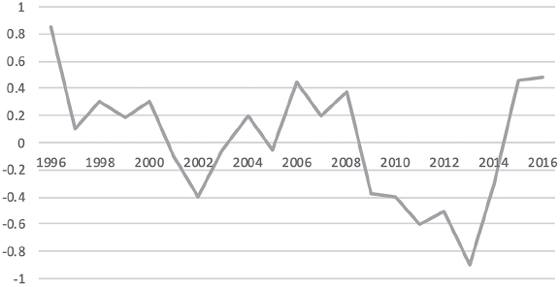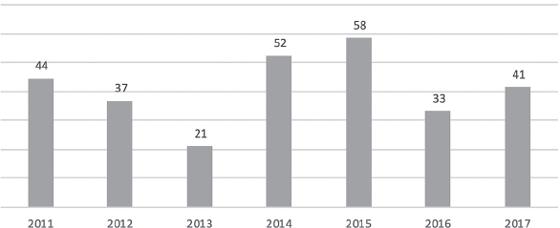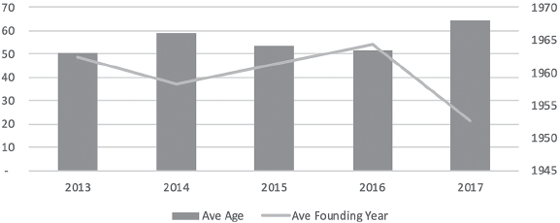IN
CHAPTER 1, I sought to test out the commonly held belief that entrepreneurs, rather than employees, are the drivers of innovation. Here I provide findings from that research.
Employees, not entrepreneurs, have been the primary source of the most transformative innovations over the past three decades, as shown in
table 1.1 (
chapter 1). But are things changing? The Kauffman Foundation, the leading research institution dedicated to the study of entrepreneurship, tracks a “Startup Activity Index,” which integrates several timely measures of entrepreneurial activity into one composite indicator. It relies on three components to measure startup activity:
1• Rate of new entrepreneurs
• Opportunity share of new entrepreneurs
• Startup density (startups per 100,000 population)
As the graph in
figure A.1 shows, with the exception of an uptick in 2015 and 2016 (the most recent years available as of this writing), startup activity has been in decline over the past two decades.
Figure A.1 Kauffman Foundation Startup Index. Source: “2017 Kauffman Index of Startup Activity,” Ewing Marion Kauffman Foundation, 2017.
If it were true that entrepreneurs are increasingly becoming the innovators, we would expect to see the lists of highly innovative companies increasingly populated by younger companies. To test this, using the
Forbes list of the most innovative companies from 2011 through 2017, we calculated how old each company was when it made the list. If younger companies are starting to replace older ones, the average age should come down. As the graph in
figure A.2 shows, it does not. We may
think old companies like GE and J&J are being replaced by younger innovators like Tesla or Spotify, but the data don’t support that. If anything, the most innovative companies are getting older.
Figure A.2 Average age of companies on the Forbes most innovative list. Source: Forbes Most Innovative Company rankings 2011–2017, Author’s analysis
Perhaps “company” is the wrong unit of measure. After all, smaller, entrepreneurial companies don’t yet have the scale to launch multiple innovations in any given year, so the “most innovative companies” list might skew toward larger organizations. We looked instead at the frequency of innovations. Using
R&D magazine’s annual list of one hundred top innovations from 2013 to 2017, we looked at how old the company behind each innovation was when its innovation made the list. If younger companies are starting to outinnovate incumbents, we should see an increasing prevalence of younger companies on the list. As the graph in
figure A.3 shows, the data support no such trend.
Figure A.3 Average age and founding year of organizations making the top 100 innovations list.




